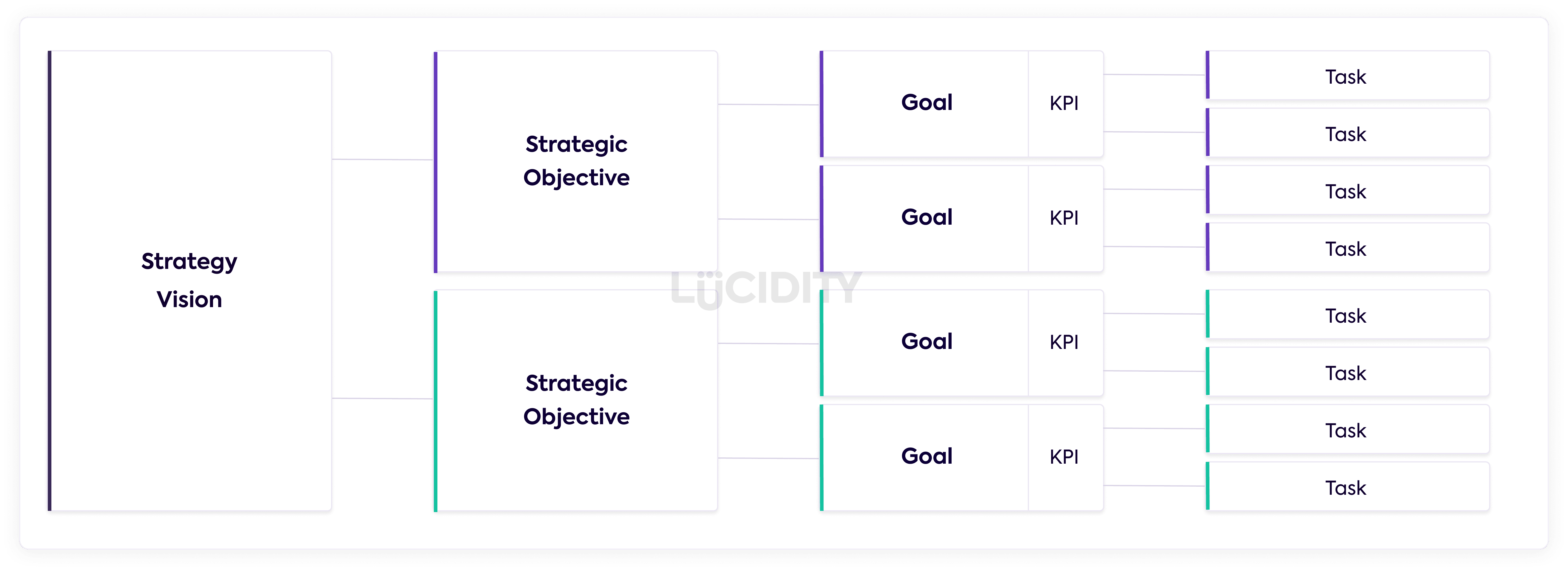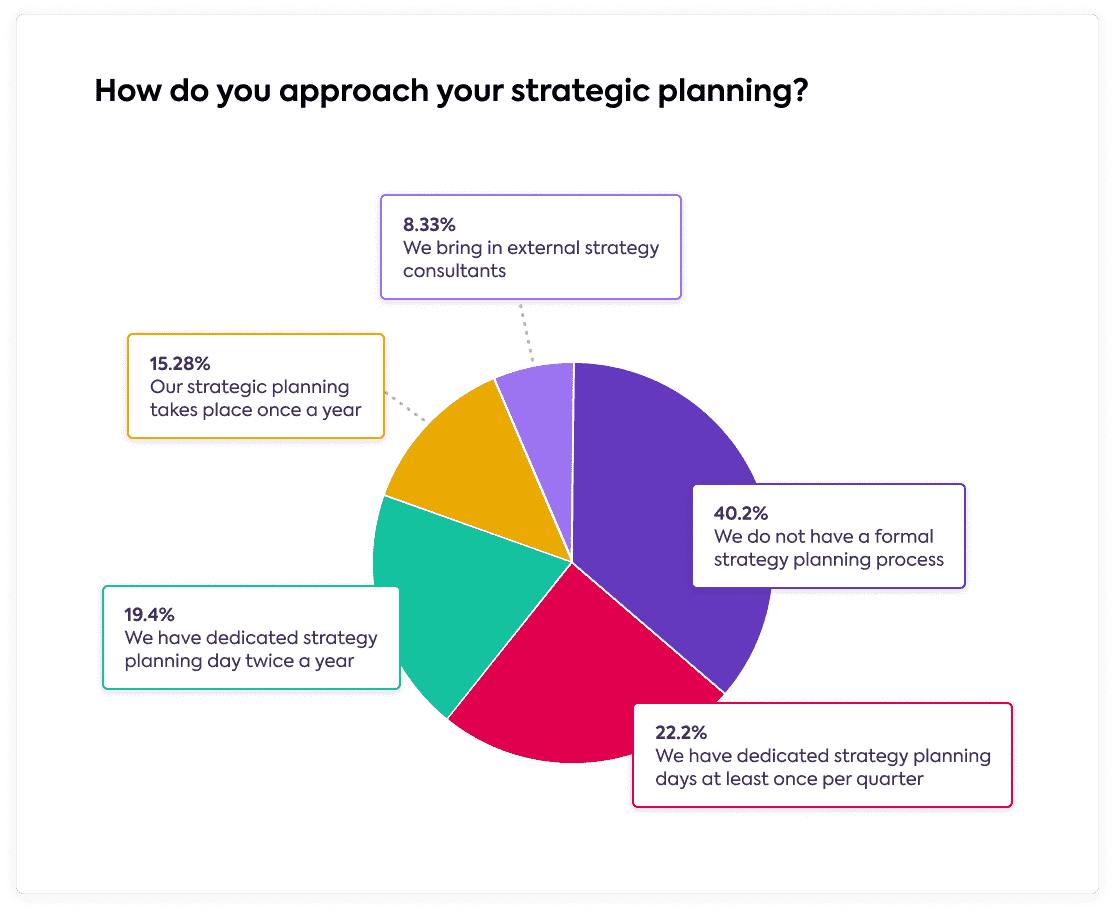When you’re looking to develop your strategy it can often be confusing as to how to structure your thinking and plans. Fear not – there’s a simple approach that can help you map out everything you wish to achieve.
It begins with a Vision Statement and possibly a Mission Statement, before moving on to Strategic Objectives. Under Strategic Objectives sit your Goals and Initiatives, and under those sit your day to day Tasks.

In this article we’ll examine Strategic Objectives in a bit of detail.
What are Strategic Objectives?
Let’s begin by looking at what Strategic Objectives are and their purpose within your strategic plan. Strategic Objectives are the major things you wish to achieve within your plan.
In a company strategy you often find Strategic Objectives that focus on the following areas:
- Growth
- Financial Return
- Customer
- Team
- Diversification
- Cost
- Operational
So let’s turn the above into a real example. If we take a real Dentist, their Strategic Objectives are:
- Fantastic Marketing
- Automated Finances
- Skilled Team
- Remote Capable
- Develop Cosmetic Services
- Open New Clinic
- Profitable Operations
You can see from the above how they are the broad outcomes and desires for the particular business leaders. Now let’s use the same framework and take a look at what a technology company has for their Strategic Objectives:
- Attract Investment
- Diversify Product Range
- Strong Financial Results
- Highly Skilled Team
- Effective Self Service Marketing
Each type of strategy will have different objectives. As a last example we’ll look at what a marketing strategy may contain as their objectives:
- Exceptional Web Presence
- Complete Understanding of Customers
- Excellent Customer Loyalty
- Skilled and Developed Team
- Engaging Industry Events
It’s helpful to consider these strategic objectives as categories, ways to group the Goals, Initiatives, Projects and KPIs you have within your strategy. It becomes a simple way to understand everything going on that relates to specific activity within the business.
Keep in mind, sometimes you have more than one major Strategic Objective within a category. For example, a company in distress may have Cost Reduction as a Strategic Objective, along with one around their Financial Performance.
The Importance of Planning
Strategy is about choice – what to do and what not to do in order to grow. It’s absolutely vital to hitting your full potential, yet strikingly just over 40% of businesses stated that they do not have a formal strategy planning process.
Data from Barriers to Growth report
Strategy is complicated and involves a number of stages of analysis. There is a lot going on both in and outside of your company to consider. Many choices that need to be made that ultimately form the direction of travel.
Yet despite much analysis and complication, successful execution requires a level of simplicity. This is where your Strategic Objectives can really help. It’s no surprise that over 50% of companies are dedicating time to strategic planning over the course of the year.
“If you don’t know what you are aiming for, how can you measure it, how can you manage it, how do you know what success looks like? Strategy and business planning are key for us in delivering success for our clients, measuring our achievements and showcasing our contribution to ensuring they achieve their organisational objectives.”
– Joanna Marsh, Publishing Director of RedActive
Clarity & Communication
One of the major advantages of using the Objective->Goal->Task model is around communication. Having the ability to showcase your strategy as a set of high-level objectives provides you with the communication without needing to go into the detail of the business.
Strategic Objectives are very easy to remember. They’re usually a title, a description and an image. Simple and effective, without the need to understand all the detail that sits below the tree level.
According to MIT research, only 13% of front-line staff could list one of their strategic objectives. That’s pretty stunning. These are the teams who are making the strategy a reality, yet almost 90% don’t know what it is. Perhaps more surprisingly, the same research discovered that only 28% of the company leaders could list three objectives.
The findings didn’t end there. In some cases, one third of company leaders couldn’t list even one of their company’s strategic objectives either.
Imagine if one third of the team who are leading your business don’t actually know your Strategic Objectives or intent. This sort of fact is why talented teams often fail or don’t hit their full potential.
There are numerous reasons that contribute to this lack of strategic alignment in a business but perhaps the biggest is lack of clear communication.
It might be that the management team themselves don’t agree or the objectives are over-complicated, but ultimately this behaviour all leads to a lack of understanding or engagement from employees.
“Always work to a plan, with clear outcomes and objectives, and a business model that the team believe in and are inspired to deliver.“
– Ben Allen, CEO of Mark Allen Group
Deciding your Strategic Objectives
At a company level, deciding the right strategic objectives for your business comes from looking at three important considerations.
Desired Outcome
The first is your overall desired outcome as a company leader or leadership team. It might be you are looking to exit in a few years or that you wish to expand internationally. Whatever your outcome, it’ll impact your core objectives.
Your Vision
Consider your Vision statement and what you need to do in order to make it a reality. You should have a direct link between your objectives and your vision statement.
Your Industry or Market
There are a lot of factors to consider when undertaking thorough strategic planning, as your market or industry will have a huge influence on your objectives. It could be competitor activity or the stage of life your industry is in, for example. There are plenty of tools and frameworks that can help. It’s worth exploring the range of strategic tools and deciding which will help you gain the insight you need. For example, if you want to establish the competitiveness of your market, then consider Porter’s Five Forces. Or, if you want to consider how to approach a market then Bowman’s Strategy Clock might well be the way.
At a departmental strategic level, deciding the right strategic objectives come down to examining what you need to achieve to support the wider company strategy. It’s often the case this involves a deeper market analysis, examining specific competitors with Four Corners Analysis or looking at innovation approaches.
Key Learnings on Strategic Objectives
Creating and developing successful objectives often share common traits. Let’s take a look at some of them which are worth keeping in mind when you compose your own Strategic Objectives.
They are simple
Keeping your objectives simple is really important, as it’s one of the biggest factors in making them memorable and engaging. Objectives should be around one category and not be too convoluted. Remember, simple doesn’t mean they aren’t deep or meaningful, it just means at a high level they are understandable.
They are meaningful
It’s really important that the objectives are engaging for your team. It should be clear as to why this is a Strategic Objective for the business and what element it contributes to the overall vision
They are engaging
In order to ensure people remember your objectives, you have to make them engaging. There are ways you can do this, such as catchy titles or visualisations. Teams will respond well to graphical strategic objectives, so associate some sort of icon or imagery with your objectives.
They are specific
A good strategy has between 3 – 6 strategic objectives. Anymore and you risk diluting the importance, losing clarity and focus, and team members number remembering the different aspects of your plan.
They relate to the day to day
The above tips all look at keeping objectives simple, engaging, and easy to remember. That’s all true but it’s equally important to have content under your objectives. The specific KPIs, Goals, Projects and Initiatives must be placed under the objective so that everyone is clear how their work contributes to the overall strategic plan.
Summary
Deciding your Strategic Objectives requires a mix of looking both inward at your own intentions and skills, as well as outwards at your market and competitors. They are the foundation of your core activity and as such a really fundamental part of any strategic plan.
When done well, they provide structure, clarity, organisation and focus to both company wide and departmental strategies. They can help you communicate; they can help you assign resource and they can help you evaluate if your strategy is a success.












